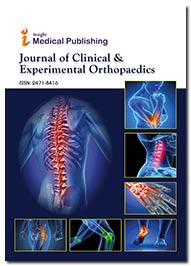Postoperative Complications in Spinal Fusion Surgery: A Retrospective Clinical Analysis
Markus Steiner
Department of Orthopaedic Research, University Hospital Zurich, Zurich, Switzerland
Published Date: 2025-02-28DOI10.36648/2471-8416.11.1.318
Markus Steiner*
Department of Orthopaedic Research, University Hospital Zurich, Zurich, Switzerland
Corresponding author:
Markus Steiner,
Department of Orthopaedic Research, University Hospital Zurich, Zurich, Switzerland,
E-mail: markus.siner@era.ch
Received date: February 03, 2025, Manuscript No. Ipjceop-25-20802; Editor assigned date: February 05, 2025, PreQC No. ipjceop-25-20802 (PQ); Reviewed date: February 17, 2025, QC No. Ipjceop-25-20802; Revised date: February 22, 2025, Manuscript No. Ipjceop-25-20802 (R); Published date: February 28, 2025, DOI: 10.36648/2471-8416.11.1.318
Citation: Steiner M (2025) Postoperative Complications in Spinal Fusion Surgery: A Retrospective Clinical Analysis. J Clin Exp Orthopr Vol.11 No.1: 318.
Introduction
Spinal fusion surgery is a widely performed procedure for treating a variety of spinal pathologies, including degenerative disc disease, scoliosis, spondylolisthesis, trauma, and tumors. By permanently joining two or more vertebrae, spinal fusion provides mechanical stability and alleviates pain associated with spinal instability. Despite its effectiveness, the surgery is complex and carries a significant risk of postoperative complications that may compromise outcomes. A retrospective clinical analysis of such complications is essential for improving perioperative care and long-term prognosis. Postoperative complications following spinal fusion can be broadly categorized into surgical site-related issues, hardware-associated problems, neurological complications, and systemic medical complications. Understanding their incidence, risk factors, and clinical impact enables surgeons to adopt preventive measures and optimize patient outcomes [1].
Description
One of the most common complications is surgical site infection, which can be superficial or deep. Deep infections involving instrumentation are particularly challenging, often requiring prolonged antibiotic therapy or revision surgery. Risk factors include long operative times, diabetes, obesity, smoking, and immunosuppression. Retrospective analyses consistently highlight infection as a leading cause of postoperative morbidity in spinal fusion patients. Hardware-related complications such as screw loosening, rod breakage, and graft non-union (pseudoarthrosis) significantly affect surgical success. Pseudoarthrosis, defined as the failure of bone fusion, is associated with persistent pain, deformity, and the need for revision procedures. Radiographic surveillance and long-term follow-up are critical in detecting these complications early. Advances in surgical techniques and biomaterials have reduced, but not eliminated, hardware-related issues. Neurological complications remain a major concern, particularly in surgeries involving deformity correction or multilevel fusion [2].
While many neurological deficits are transient, some may result in permanent disability. Retrospective analyses suggest that intraoperative neuromonitoring reduces the incidence of severe neurological complications. In addition to local complications, spinal fusion patients are at risk for systemic medical complications such as deep vein thrombosis, pulmonary embolism, pneumonia, and cardiac events. These risks are especially pronounced in elderly patients with multiple comorbidities. Prophylactic anticoagulation, early mobilization, and vigilant postoperative monitoring are critical strategies in minimizing systemic complications [3].
Another important outcome of retrospective analyses is the identification of patient-related risk factors. Obesity, advanced age, diabetes mellitus, osteoporosis, smoking, and poor nutritional status significantly increase the risk of adverse outcomes. Recognizing these risk factors preoperatively allows for better patient selection, optimization of comorbidities, and personalized perioperative care. Length of hospital stay and reoperation rates are important clinical indicators of postoperative complications. Infections, pseudoarthrosis, and hardware failure are the most common causes of reoperation. Retrospective studies indicate that nearly 10â??15% of spinal fusion patients may require revision surgery within five years, underscoring the long-term burden of postoperative complications [4].
Advances in minimally invasive spinal fusion techniques have been associated with reduced blood loss, shorter hospital stays, and lower infection rates compared to traditional open fusion. However, these approaches may still carry risks of malpositioned instrumentation and nerve injury. Continued refinement of minimally invasive approaches and the use of navigation and robotic assistance are expected to improve safety profiles. The economic burden of postoperative complications in spinal fusion is substantial. Prolonged hospital stays, additional imaging, revision surgeries, and rehabilitation contribute to escalating healthcare costs. Despite these challenges, ongoing research and retrospective analyses contribute to improved preventive strategies [5].
Conclusion
Postoperative complications remain a significant concern in spinal fusion surgery, impacting patient outcomes, healthcare resources, and quality of life. Retrospective clinical analyses provide valuable insights into the incidence, risk factors, and long-term consequences of these complications. By integrating such evidence into clinical practice, surgeons can refine surgical techniques, adopt preventive measures, and personalize perioperative care. As innovations in minimally invasive approaches, biomaterials, and perioperative protocols continue to evolve, the burden of postoperative complications in spinal fusion surgery is expected to decline, ultimately improving safety, cost-effectiveness, and patient satisfaction.
Acknowledgement
None.
Conflict of Interest
None.
References
- Switlyk MD, Kongsgaard U, Skjeldal S, Hald JK, Hole KH, et al. (2015). Prognostic factors in patients with symptomatic spinal metastases and normal neurological function. Clin Oncol27: 213-221.
Google Scholar Cross Ref Indexed at
- Chang SY, Ha JH, Seo SG, Chang BS, Lee CK, et al. (2018). Prognosis of single spinal metastatic tumors: Predictive value of the spinal instability neoplastic score system for spinal adverse events. Asian Spine J12: 919.
Google Scholar Cross Ref Indexed at
- Shehadi JA, Sciubba DM, Suk I, Suki D, Maldaun MV, et al. (2007). Surgical treatment strategies and outcome in patients with breast cancer metastatic to the spine: A review of 87 patients. Eur Spine J16: 1179-1192.
Google Scholar Cross Ref Indexed at
- Newman WC, Amin AG, Villavieja J, Laufer I, Bilsky MH, Barzilai O. (2021). Short-segment cement-augmented fixation in open separation surgery of metastatic epidural spinal cord compression: initial experience. Neurosurg50: E11.
Google Scholar Cross Ref Indexed at
- Clements, D. H, Betz, R. R, Newton, P. O, Rohmiller, M, Marks, M. C, & Bastrom, T. (2009). Correlation of scoliosis curve correction with the number and type of fixation anchors. Spine, 34(20: 2147-2150.
Open Access Journals
- Aquaculture & Veterinary Science
- Chemistry & Chemical Sciences
- Clinical Sciences
- Engineering
- General Science
- Genetics & Molecular Biology
- Health Care & Nursing
- Immunology & Microbiology
- Materials Science
- Mathematics & Physics
- Medical Sciences
- Neurology & Psychiatry
- Oncology & Cancer Science
- Pharmaceutical Sciences
